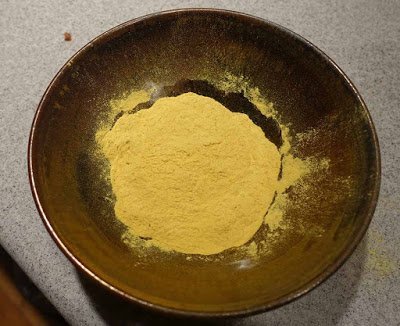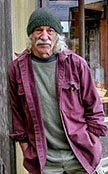Sacred in some circles, but require rather bizarre method of activating psychoactive properties. Fly agaric, amanita muscaria
 It’s been a good week for food from close by. I went out Friday in my (12′ Scrambler) kayak and spent almost 5 hours between paddling and digging (and raking) for cockles and horseneck clams, resulting in clam fritters and tonight, clam linguine. Got 4 rock crabs that were scooting around in the shallows.(Also ended up pretty exhausted.)
It’s been a good week for food from close by. I went out Friday in my (12′ Scrambler) kayak and spent almost 5 hours between paddling and digging (and raking) for cockles and horseneck clams, resulting in clam fritters and tonight, clam linguine. Got 4 rock crabs that were scooting around in the shallows.(Also ended up pretty exhausted.)
Bought a small halibut from a neighbor fisherman, was given 4 rock fish by a friend, and got a bunch of smelt at night.
On Tuesday I was going to hike along the coast and noticed that the cattails were pollinating and got the pollen shown in the photo (you bend the stalks over and shake into a paper bag) — took maybe a half hour to get this much. I added it to oat pancakes this morning. All our vegetables are coming from the garden this time of year.
(Two weeks earlier I burned up my Evinrude 2-stroke outboard motor (seaweed clogged water intake) AND on same day got truck stuck in the bay and was pulled out by tow truck just as the water got up to the floorboards — close call! — but that’s all another story…)
Listening to Mojo Nixon’s “Loon in the Afternoon” program on Sirius Outlaw Country station right now.
 “UC Berkeley professors Philip Stark and Tom Carlson are self-proclaimed botanical rubberneckers. When both of them walk their daily route to campus, it’s rare that they’ll take a few steps without stopping in their tracks, bending down, and finding some food to snack on.
“UC Berkeley professors Philip Stark and Tom Carlson are self-proclaimed botanical rubberneckers. When both of them walk their daily route to campus, it’s rare that they’ll take a few steps without stopping in their tracks, bending down, and finding some food to snack on.
Their wild snacks are what most people would call weeds.
Weeds, they say, get a really bad rap. Instead Stark and Carlson want people to think of them as wild edibles, underprivileged plants, or forgotten foods. ‘They’re just an incredible resource and we’re not using them,’ Stark says.'”…
https://blogs.kqed.org/bayareabites/2015/02/05/snacking-in-between-sidewalks-mapping-abundance-of-wild-edibles-in-the-bay-areas-food-deserts/

It’s raining, not pouring, but hey! It’s lovely—highly unusual for us in summer…I finally got our well (for watering garden) going again yesterday. New jet pump, new 80-gallon pressure tank…it’s a 15′ deep well that we dug with a backhoe in 1980…put 8″ pipe with saw kerfs (slits) in middle of hole, filled with rock…1-1/4″ pipe goes down inside the 8″ pipe…used the soil we dug out to make adobe bricks with a Cinva-Ram, and they form the back wall of our greenhouse…retains heat nicely…corn is 8′ high, more vigorous than ever before…I’ve been collecting seaweed, last week got leafy parts of bull kelp, dried it, and it’s really salty and flavorful…I’m a couple of years ahead on firewood…we end up with a lot of pallets from book shipments, and lately they’re all heat treated (“HT” stamped on them), meaning they haven’t been insecticided, so I cut them up with chainsaw, good addition to oak and euc picked up on road…we just added a new hoop greenhouse from Farmtek…”EZ Build Gro Cold Frame,” very simple, quick to put up, metal hoops (a la quonset shape), 10′ wide x 14′ long x 7′ high, UV stabilized flexible woven poly fabric, lasts 10 years…it’s really warm, even on overcast days…tomatoes, peppers, cucumbers…
A great crowd at Gallery Bookshop in Mendocino last night for my Tiny Homes on the Move slideshow. In addition to the 50 or so mobile homes I showed, we talked about farming, building methods and materials, the ’60s*, and building codes. I looked at the roomful of people — we were all on the same page — causing me to reflect on who are these people, who are “we?”
Dwell magazine, bless its sterile heart, is the completely other side of the picture and, due to its popularity, I would guess our group is in the minority — kind of like the book lovers in Fahrenhei 451. I’ve been trying to define the characteristics of our group. We believe in doing things with our own hands…natural materials…craftsmanship…working kitchens…solar heated water…colorful interiors…Feng shui…gardens, chickens, foraging. One of these days I’ll write something about who we are. In the meantime, heh-heh, check out https://www.theshelterblog.com; this is the kind of stuff we like.
*I said to someone recently, “Well, the ’60s happened in the ’70s — no actually, the ’60s happened in the ’60s and the ’70s — and she said, “The ’60s are still happening.” In many cases, being rediscovered.

Rick Gordon has built it and we’ve been tinkering with it for a few months, and finally it feels ready to go. Whereas my blog is all over the place, The Shelter Blog will focus on homes, building, carpentry, gardening, farming, foraging, fishing, homesteading and the home arts. Check it out here:
https://www.theshelterblog.com
Note: it’s theshelterblog.com, not shelterblog.com. You need the article the.
I’m really excited by this. It’s as important — maybe in the long run more so — than one of our books. We have no competition here, since we have feedback from our 40 years publishing books on the subject of shelter. Plus we can share brand-new incoming photos and stories rather than wait years to get same into a book. It’ll be complimentary to our books.
We guarantee at least one new post per day, hope to get multiple posts daily as we get rolling.
Tags: architecture, barns, builders, carpentry, cooking, crafts, fishing, food, foraging, gardening, homes, homesteading, small homes, solar, tiny homes, tiny homes on the move, tiny houses, tools, vehicles, woodwork  At left: crab snare; you toss it out with a fishing rod, wait 15 minutes and reel it in. It snags crabs in the loops.
At left: crab snare; you toss it out with a fishing rod, wait 15 minutes and reel it in. It snags crabs in the loops.
Yesterday I went on a 3-hour tour with Kirk Lombard on the shores of San Francisco Bay. He demonstrated catching crabs with crab snares, how to throw a net to catch herring, and how to catch eels. Kirk is passionate about the ocean, sustainability, and getting your own food. He leads tours of various types, takes people clamming or herring-catching, and has a seafood subscription service. He says there are numerous small fish in this area — smelt, sand dabs, herring, sardines — that are overlooked by commercial interests and perfect for the get-it-yourselfer.
I’ve poked around on the local coast all my life and come from a family of fishermen — all sport fishermen except for my grandfather, who had a bait and tackle shop in SF around the turn of the century — but I learned a ton of things. There’s a 300-foot deep channel under the Golden Gate Bridge carved out in old times by the Sacramento River. You can make a pudding from a type of seaweed. Fish that is touted as “local” often comes from boats that spend over a month at sea, with 65-mile long longlines.
There were two 12-year-old boys in the group and he was the perfect teacher. He got them reeling in crabs, throwing a herring net correctly, and poke-poling for eels. If you’ve got kids in the Bay Area,this is a wonderful learning experience. If you’re a city-dweller interested in bringing in some of your own fresh seafood, check him out. 6-star.
https://www.seaforager.com/
I’m the dunce fisherman of my family. My grandfather had a bait and tackle shop in San Francisco in the early 1900s (and made bamboo fishing rods), my dad was a fresh and salt water fisherman, my brother Bob has for years had a Double-ended Monterey, my brother Carl fished commercially for a while. And me — I guess I just don’t have the patience — if they’re not biting, I’m outta there.
 BUT I’m trying to increase my seafood intake. Saturday went on long beach walk with my buddy Jack Fulton, picked up some mussels (had for dinner last night). Jack shot this pic of me heading out to the mussels.
BUT I’m trying to increase my seafood intake. Saturday went on long beach walk with my buddy Jack Fulton, picked up some mussels (had for dinner last night). Jack shot this pic of me heading out to the mussels.
Then last night I managed to catch 4 eels and now I’m gonna prepare them to be smoked tomorrow.
It’s, um, possible I’ve said all this before — ah, me.











